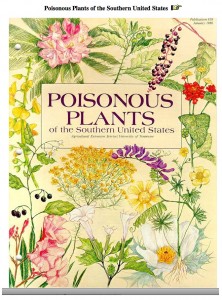The number one rule for plant identification is “safety first.” Prior to practicing skills of plant identification through personal investigation of plants in your region, you must learn to quickly and confidently identify poisonous plants specific to your area. The plants to study first are the ones which cause skin reactions from contact with the plant.
A recommended field guide for poisonous plants is Venomous Animals & Poisonous Plants — a book in the Peterson Field Guides series.
By studying the information referenced at Identify that Plant, you may learn about and really come to “know” plants in your area which are hazardous or poisonous. A plant may be deemed poisonous to humans (animals are a different story!) because the plant causes a skin reaction and/or the plant is dangerous through bringing some portion of it into your body via eating, or breathing the burning plant’s smoke.
Listed below are two sets of links to websites with information about poisonous plants. The first set of links connects you with regionally listed plants. The second set focuses on specific hazardous plants which cause skin reactions.
Regional lists and descriptions of poisonous plants
Poisonous Plants of North Carolina — Information provided includes excellent photos as well as a description of the plant, the poisonous part(s), symptoms of poisoning, and where the plant can be found.
Common Poisonous Plants — This list of plants, provided by Texas AgriLife Extension Service, includes the poisonous plant part and symptoms of poisoning.
 Poisonous Plants of the Southern United States — Although the focus is on the harm to livestock, this reference provides good photos and descriptions of a long list of plants.
Poisonous Plants of the Southern United States — Although the focus is on the harm to livestock, this reference provides good photos and descriptions of a long list of plants.
Poisonous Plants in New Zealand — Although no photos are provided, the list does outline some basic information about each plant.
 Australian Native Poisonous Plants — This article discusses poisonous plants native to Australia.
Australian Native Poisonous Plants — This article discusses poisonous plants native to Australia.
Specific hazardous plants
A comprehensive site about three common poisonous plants is the Poison Ivy, Oak, & Sumac Information Center.
Sites about poison ivy . . .
- From poison-ivy.org
- Eastern poison ivy from USDA plants database
Sites about poison oak . . .
- From Wayne’s Word
- Atlantic poison oak from USDA plants database
- Pacific poison oak from USDA plants database
Sites about poison sumac . . .
Sites about stinging nettle . . .
- From Steve Brill (Click on “Nettles.”)
- From USA plants database
- How to treat a sting from stinging nettle




